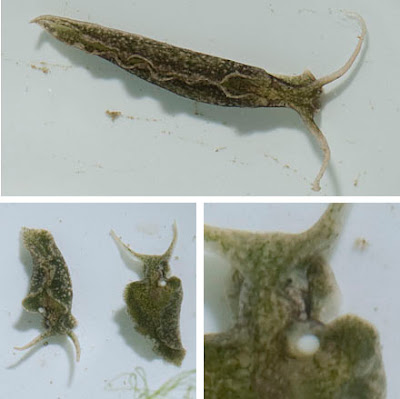A tiny snail that I've never seen before! And more stuff I'm seeing for the first time!
On a rather 'beat-up' Seletar shore, distracting us from a search for anemones.
Here's a look at the underside of the snail. It has a dark 'door' or operculum. The animal is pale with yellow spots on its foot and even tentacles. It moves very fast. I tried to find more but couldn't find any others. I have no idea what this snail is.
There were also several tiny slugs on the fine green hairy seaweeds that were blooming on the shore. I don't remember seeing this kind of seaweed before. Swimming Camera struggles to take a photo of the slug.
Here's a better photo when I got a closer look at them later on. Thank goodness Jose found a much larger one. The others are so tiny! They look like some kind of sap-sucking slug (Order Sacoglossa), probably a kind of Elysia. They had one pair of very long tentacles with tiny eye spots at the base, and a body in two 'wings' with a tiny lump in the centre. They move very fast.
When moving, they are long and slender. As usual, when several of these slugs are close together, they get in the mood for reproduction. The little white dots on the 'neck' are probably the penis. These animals are hermaphrodites and fertilise each other.
Another first time encounter for me was with these tiny things floating in the water. Wow, they look like the moults of barnacles (Class Cirripedia)!
Looking at their moults, it is quite obvious that they are crustaceans! In their 'shells', they are often mistaken for molluscs. The feathery fan are modified legs. The big baggy thing is probably the body. They remind me of weird shrimps!
There were some with a very long tubular thing. Could this be the much talked about penis of a barnacle? The barnacle may have a penis that is long enough to fertilise another barnacle several 'shells' away!
It's amazing what we can find when we take a closer look at any shore, no matter how humble. We were here to look for burrowing anemones. And we found many of the 'dark' burrowers. But alas, none of the 'light' burrowers.
There were also lots of little anemones stuck on shells, of living snails or the shell occupied by hermit crabs. One small shell may have four or more anemones! I'm not sure why this tends to happen on such silty, muddy shores.
Jose spotted this large anemone in the middle of soft squishy muddy sand. I'm not sure if it's 'Bob' the unidentified Plain anemone or 'Bill' the unidentified Bumpy mangrove anemone. So much more to figure out about our shores!
There were lot and lots of Hairy sea hares (Bursatella leachii) on the shore! Jose spotted the first one, and then we started seeing them everywhere. These shaggy looking slugs with electric blue spots are seasonal. At times found in large numbers, then none seen for a long while. They produce a purple ink when they are disturbed.
Their egg masses were also found in clumps here and there, looking like piles of bizarre noodles.
We also came across a patch of many tiny little Onch slugs (Family Onchidiidae) that are not familiar to me.
I saw this little soft lump and thought it was another kind of slug. But no, it was a Silt flatworm wrapped around a little clam!
Probably disturbed when I touched it, the flatworm rapidly slithered away into the sand, leaving the clam to live another day. Flatworms are really flat and can stick their feeding 'tube' through the tiniest crack to eat all kinds of hapless prey.
I saw one Tiger moon snail (Natica tigrina). These moon snails seem to like muddy shores.
Towards sunset, Jose noticed the little Sand stars (Astropecten sp.) starting to emerge.
Jose also found a tiny little pipefish (Family Syngnathidae). I think it's a young one, so after having a look at it, we left in the pool among the seaweeds.
We had a great time on this little sand bar near the mangroves at Seletar, under a changeable sky.
On the clean sand, we noticed the little footprints of a bird, and signs of crabs in the sand.
Two photographers spent a long time taking photos here. How nice to know people make the effort to document our wild places!
The walkway that Andy and I saw being built during our last trip to Seletar in Sep 2011 is already complete! There were a few men digging in the mud, and on the shores too. Across the narrow Johor Strait are the massive industrial areas in Johor.
Sadly, a great deal of litter has accumulated on the high shore. This generally happens on all our shores, so it's not necessarily a sign of littering by the people who work or live here.
But all our shores can be fascinating. Even on our short trip, I found so many interesting things that I've never seen before!
More about Seletar in this earlier post.
























